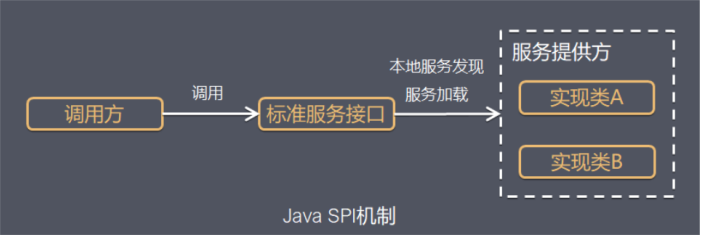1、What is SPI???
1、SPI{Service Procider Interface},是JDK内置的一种服务提供发现机制。2、SPI是一种动态替换发现的机制,比如有个接口,想运行时动态的给它添加实现,你只需要添加一个实现。3、如下图中:接口对应的抽象SPI接口,实现放实现SPI接口,调用放依赖SPI接口。4、SPI接口定义在调用方,在概念上更依赖调用方。 4-1、当服务的提供者提供一个接口的实现之后,需要在classpath下的META-INF/service/目录下创建一个以服务接口命名的文件,这个文件里的内容就是这个接口的具体的实现类。 4-2、当其他的程序需要这个服务的时候,就可以通过查找这个jar包(一般都是以jar包做依赖)的META-INF/services/中的配置文件,配置文件中有接口的具体实现类名,可以根据这个类名进行加载实例化,然后就可以使用该服务了。 4-3、JDK中查找服务实现的工具类是:java.util.ServiceLoader.
1-1、SPI-概念示意图

1-2、SPI的用途-举例
1、SPI机制应用:DriverManager、Spring、ConfigurableBeanFactory等。
1-2-1、SPI的用途-举例-DriverManager
1、DriverManager 是 jdbc 里管理和注册不同数据库 driver 的工具类。针对一个数据库,可能会存在着不同的数据库驱动实现。我们在使用特定的驱动实现时,不希望修改现有的代码,而希望通过一个简单的配置达到效果。2、Driver源码: public class Driver extends NonRegisteringDriver implements java.sql.Driver { public Driver() throws SQLException { } static { try { //静态代码块中,调用DriverManager的注册驱动方法new一个自己当参数传给驱动管理器 DriverManager.registerDriver(new Driver()); } catch (SQLException var1) { throw new RuntimeException("Can't register driver!"); } } } 3、Mysql DriverManager 源码: public class DriverManager { // List of registered JDBC drivers private final static CopyOnWriteArrayList<DriverInfo> registeredDrivers = new CopyOnWriteArrayList<>(); private DriverManager(){} static { loadInitialDrivers(); println("JDBC DriverManager initialized"); } //静态内部类,用到了SPI工具类ServiceLoader private static void loadInitialDrivers() { String drivers; try { drivers = AccessController.doPrivileged(new PrivilegedAction<String>() { public String run() { return System.getProperty("jdbc.drivers"); } }); } catch (Exception ex) { drivers = null; } AccessController.doPrivileged(new PrivilegedAction<Void>() { public Void run() { // 用到了SPI工具类ServiceLoader ServiceLoader<Driver> loadedDrivers = ServiceLoader.load(Driver.class); Iterator<Driver> driversIterator = loadedDrivers.iterator(); //加载SPI扫描到的驱动来触发他们的初始化{触发static代码块} try{ while(driversIterator.hasNext()) { driversIterator.next(); } } catch(Throwable t) { // Do nothing } return null; } }); println("DriverManager.initialize: jdbc.drivers = " + drivers); if (drivers == null || drivers.equals("")) { return; } String[] driversList = drivers.split(":"); println("number of Drivers:" + driversList.length); for (String aDriver : driversList) { try { println("DriverManager.Initialize: loading " + aDriver); Class.forName(aDriver, true, ClassLoader.getSystemClassLoader()); } catch (Exception ex) { println("DriverManager.Initialize: load failed: " + ex); } } } public static synchronized void registerDriver(java.sql.Driver driver) throws SQLException { registerDriver(driver, null); } public static synchronized void registerDriver(java.sql.Driver driver,DriverAction da)throws SQLException { /* Register the driver if it has not already been added to our list */ // 将自己注册大片驱动管理器的驱动列表中 if(driver != null) { registeredDrivers.addIfAbsent(new DriverInfo(driver, da)); } else { // This is for compatibility with the original DriverManager throw new NullPointerException(); } println("registerDriver: " + driver); } //当获取连接的时候调用驱动管理器的连接方法从列表中(之前处理的map)获取 @CallerSensitive public static Connection getConnection(String url, java.util.Properties info) throws SQLException { return (getConnection(url, info, Reflection.getCallerClass())); } // Worker method called by the public getConnection() methods. private static Connection getConnection( String url, java.util.Properties info, Class<?> caller) throws SQLException { /* * When callerCl is null, we should check the application's * (which is invoking this class indirectly) * classloader, so that the JDBC driver class outside rt.jar * can be loaded from here. */ ClassLoader callerCL = caller != null ? caller.getClassLoader() : null; synchronized(DriverManager.class) { // synchronize loading of the correct classloader. if (callerCL == null) { callerCL = Thread.currentThread().getContextClassLoader(); } } if(url == null) { throw new SQLException("The url cannot be null", "08001"); } println("DriverManager.getConnection(\"" + url + "\")"); // Walk through the loaded registeredDrivers attempting to make a connection. // Remember the first exception that gets raised so we can reraise it. SQLException reason = null; for(DriverInfo aDriver : registeredDrivers) { // If the caller does not have permission to load the driver then // skip it. if(isDriverAllowed(aDriver.driver, callerCL)) { try { println(" trying " + aDriver.driver.getClass().getName()); Connection con = aDriver.driver.connect(url, info); if (con != null) { // Success! println("getConnection returning " + aDriver.driver.getClass().getName()); return (con); } } catch (SQLException ex) { if (reason == null) { reason = ex; } } } else { println(" skipping: " + aDriver.getClass().getName()); } } // if we got here nobody could connect. if (reason != null) { println("getConnection failed: " + reason); throw reason; } println("getConnection: no suitable driver found for "+ url); throw new SQLException("No suitable driver found for "+ url, "08001"); } }4、ServiceLoader源码: public final class ServiceLoader<S> implements Iterable<S> { private static final String PREFIX = "META-INF/services/"; private final Class<S> service; private final ClassLoader loader; private final AccessControlContext acc; private LinkedHashMap<String,S> providers = new LinkedHashMap<>(); private LazyIterator lookupIterator; //构造方法 private ServiceLoader(Class<S> svc, ClassLoader cl) { service = Objects.requireNonNull(svc, "Service interface cannot be null"); loader = (cl == null) ? ClassLoader.getSystemClassLoader() : cl; acc = (System.getSecurityManager() != null) ? AccessController.getContext() : null; reload(); } public void reload() { providers.clear(); lookupIterator = new LazyIterator(service, loader); } //内部类 private class LazyIterator implements Iterator<S> { Class<S> service; ClassLoader loader; Enumeration<URL> configs = null; Iterator<String> pending = null; String nextName = null; private LazyIterator(Class<S> service, ClassLoader loader) { this.service = service; this.loader = loader; } private boolean hasNextService() { if (nextName != null) { return true; } if (configs == null) { try { //加载META-INF/services/文件夹下类名为文件名的子类,将其加载到虚拟机 String fullName = PREFIX + service.getName(); if (loader == null) configs = ClassLoader.getSystemResources(fullName); else configs = loader.getResources(fullName); } catch (IOException x) { fail(service, "Error locating configuration files", x); } } while ((pending == null) || !pending.hasNext()) { if (!configs.hasMoreElements()) { return false; } pending = parse(service, configs.nextElement()); } nextName = pending.next(); return true; } private S nextService() { if (!hasNextService()) throw new NoSuchElementException(); String cn = nextName; nextName = null; Class<?> c = null; try { c = Class.forName(cn, false, loader); } catch (ClassNotFoundException x) { fail(service, "Provider " + cn + " not found"); } if (!service.isAssignableFrom(c)) { fail(service, "Provider " + cn + " not a subtype"); } try { S p = service.cast(c.newInstance()); providers.put(cn, p); return p; } catch (Throwable x) { fail(service, "Provider " + cn + " could not be instantiated", x); } throw new Error(); // This cannot happen } public boolean hasNext() { if (acc == null) { return hasNextService(); } else { PrivilegedAction<Boolean> action = new PrivilegedAction<Boolean>() { public Boolean run() { return hasNextService(); } }; return AccessController.doPrivileged(action, acc); } } public S next() { if (acc == null) { return nextService(); } else { PrivilegedAction<S> action = new PrivilegedAction<S>() { public S run() { return nextService(); } }; return AccessController.doPrivileged(action, acc); } } public void remove() { throw new UnsupportedOperationException(); } }}
@CallerSensitive public static Connection getConnection(String url, String user, String password) throws SQLException { java.util.Properties info = new java.util.Properties(); if (user != null) { info.put("user", user); } if (password != null) { info.put("password", password); } return (getConnection(url, info, Reflection.getCallerClass())); }


